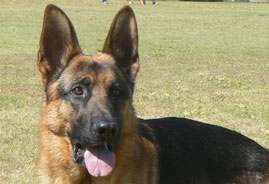Related sites with
loads of relavent and quality information:
|
Training
the Pause Table - Part 1
General
Overview
By MS du Toit
Although
the pause table seems to be a very easy obstacle to perform, it is not.
The pause table is probably the one obstacle where the most time is
lost during a course run. The table is included on a course to
demonstrate that an agility dog can not only run fast and perform
spectacular obstacles, but that he can also be controlled in a stay
position at a certain place. I have divided this article into a series
of 6 different parts, because it is a bit long. This general overview
is part 1, the send to the table
is part 2, the fast sit or down
is part 3, the secure stay is
part 4, the release
is part 5 and the chaining
is part 6. This will also have the effect that you will read each part
separately, but more importantly that you will train each part
separately.
Here follows a few
reasons for the poor table performance of an agility dog:
1. Handlers tend to think it is an easy obstacle to perform and
therefor it is not practised enough.
2. Handlers find it boring and unintencially carry that over to the dog.
3. It is not taught correctly and thoroughly to the dog.
How to teach the
pause table to the dog:
Wherever possible I always break the commands down to the simplest
forms and then, once the dog can reliably perform each segment
correctly and fast, chain it back up together. The table command is no
different. Your ultimate aim with the table command is that you should
be able to send the dog to the table from anywhere on the course, the
dog should jump on the table and immediately go into the down or sit
position (whatever is required by the judge) and remain in that
position until released. In other words you can break the table
performance into the following four things:
1. Send
to the table – the dog runs enthuciastically to the table and
jump onto the table
2. Fast sit or down – the dog
performs an immediate fast sit or down on command
3. Secure stay – the
dog performs a secure stay, not moving from that position
4. Release – the dog
performs a fast release and immediately following your hand and body to
perform the next obstacle
Chaining the
commands together
The table is one of the most easiest of the agility
obstacles that can be trained in your garden or even in the house when
it is raining outside. It is also probably the obstacle that is trained
the least and that accounts for the most time lost during a course run.
I would therefor strongly suggest that you buy a table from Affordable
Agility so that you can train your dog at home to do a solid
table performance. You can construct it yourself, but it needs to be
very secure. If your dog jump on it and it collapses under him, you wil
NEVER get a good performance from your dog. Some dogs might never even
want to come close to the table again. There are a few obstacles I
would just buy from a reliable company like Affordable Agility, and the
table is definately one of those.
MS du Toit has been training dogs for ten years.
Please visit her Dog
Training Review Page.
Back to Top
Continue to Part 2 of this series: Send
to the Table
Back to Articles

|
|

